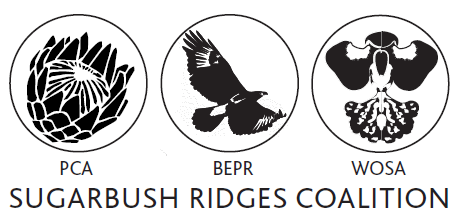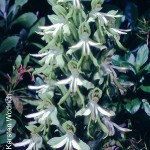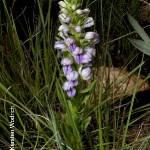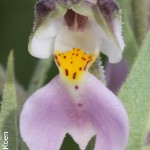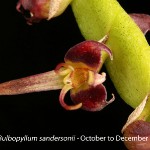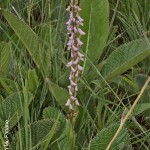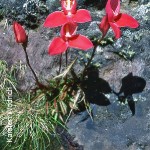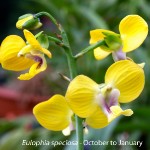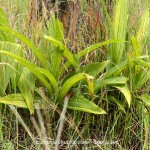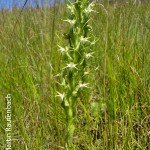Orchids by Genera
The South African Indigenous Orchids are listed below in alphabetical order starting with the genus and then following on with the species in alphabetical order under each genus. If you are looking for a specific genus use the list on the left and click on the genus. That will give you all species with that genus. Click on the little arrow to the left of the genus name in the list and a drop down box will give you all the species belonging to that genus. Here you can click on a specific species and get the information for that species only.
This section of the website is still under development. Please check back often for updates. We are still looking for photographs of some 200 of the 500 species and if you find a species description without a photograph and would like to contribute a specific photo for that species please contact us. All photographs are properly credited.
Bonatea speciosa
Description
Robust terrestrial, up to 950mm tall. Leaves 4-19 cauline, oblong to broadly spear-shaped and up to 155mm long. Inflorescence rather dense, with up to 40 flowers, which are green and white. Previously related to Bonatea antennifera which was known as Bonatea speciosa var. antennifera, while this species was known as Bonatea speciosa var. speciosa. Both varieties have now been recognised as species in their own right. Scented at dusk and pollinated by hawkmoths.
Bonatea steudneri
Description
Robust terrestrial up to 1m tall. Leaves 7-20, cauline, elliptic to spear-shaped and up to 154mm long. Inflorescence lax, 5-35 flowers, green and white in colour.
Brachycorythis conica subsp. transvaalensis
Description
Slender to fairly robust terrestrial, growing up to 400 mm tall. Leaves cauline, numerous, densely overlapping, spear-shaped to narrowly egg-shaped, up to 60 x 20 mm. Inflorescence dense, up to 150 mm long and carrying 30-40 flowers, which are mauve to pink and white, lip mauve with purple spots. Flowers extremely variable from plant to plant. Spur curving, up to 8 mm long. Has recently been given the common name: the Albertina Sisulu Orchid.
Brachycorythis pubescens
Description
Moderately robust terrestrial which grows up to 600 mm tall. Numerous leaves are cauline and densely overlapping, hairy, spear-shaped and up to 60 x 20 mm. Inflorescence dense and hairy, up to 320 mm long. 45-110 flowers are hairy on the outside, light to deep pink suffused with Brownish green, callus yellow spotted with red. Sepals and petals form a hood over the column. Sepals up to 7 x 4 mm, petals up to 6 x 3 mm. Spur absent. Similar to Brachycorythis ovata ssp. ovata.
Bulbophyllum sandersonii
Description
Slender to fairly robust epiphyte or lithophyte, with long rhizomes 2-3mm in diameter between pseudobulbs Pseudobulbs ovoid to narrowly conical, 30-50mm apart. Two leaves per pseudobulb, leathery to almost fleshy, strap-shaped to elliptic-oblong. Inflorescence lateral, erect about 100-150mm tall. Flowers borne in two rows, dull violet or green with purplish dots.
Disa aconitoides
Description
Slender terrestrial up to 600mm tall. Different to other species and quite unique. Rarely produces sterile shoots. Leaves 5-10 on sterile shoot, cauline. Inflorescence lax with 15-50 flowers, which face downwards at 45 degrees. They are off-white or flushed pale mauve with darker mauve spots. The lip has a central solid mauve line.
Disa uniflora
Description
Slender, fairly robust terrestrial, growing up to 600mm tall. Spreads via underground stolons. Leaves at the base are narrow, spear shaped and up to 250 mm long. Inflorescence usually has 1 flower, but can sometimes have up to 3. Lateral sepals and lip carmine in colour with a sparkling texture when viewed in full sunlight. Galea orange or yellow inside with red spots and forked veins. Yellow flowered specimens have also been found. This species is very variable in the size of the plants and colouration of the petals and sepals. This is undoubtedly our most spectacular and well-known orchid and is in the badge of the Western Province Rugby Union.
Eulophia speciosa
Description
Robust terrestrial, up to 900mm tall. Partly visible pseudobulbs sometimes evident. Leaves succulent, fully developed at flowering time, up to 650 mm long. Inflorescence lax, with 10-30 flowers. Sepals pale green, petals and lip yellow, lip side lobes with purple lines, crests deep yellow. Sepals reflexed, up to 13 mm long, lip 3-lobed, spur up to 3 mm long. Pollinated by carpenter bees. Syn: Eulophia austrooccidentalis, Eulophia leucantha, Eulophia wakefieldii.
Eulophia streptopetala
Description
Robust terrestrial with flowering stems that can grow up to 2.5m tall. The pseudobulb grows partially above the ground (much like a Cymbidium) and is up to 40 mm in diameter. The new growths develop from the base of the previous seasons matured pseudobulbs and the leaves are partially to fully developed when flowering. Leaves number between 4 and 9 and have a distinct ribbing appearance. The inflorescences, which grow next to the new growth with the developing pseudobulb, carries between 10 and 40 flowers. These are borne sequentially. Sepals are olive-green to green and are suffused with a reddish-brown. The petals are a chrome-yellow colour. No fragrance has been detected. The spur is 2mm in length.
Habenaria cornuta
Description
Fairly robust terrestrial, up to 600mm tall. Leaves numerous, cauline, elliptic to narrowly spear-shaped, up to 100mm long. Inflorescence fairly dense, 8-20 flowers, which are green. Sepals up to 16mm long, median deflexed, laterals somewhat rolled up lengthwise. Petals divided, lower lobe curving upward like a horn, up to 45mm long, upper lobe erect, linear, up to 15mm long. Lip 3-lobed, up to 19mm long, with lobes almost equal, spur twisted once and inflated apically, up to 25mm long. Similar to Habenaria clavata, but has inconspicuous green stigmatic arms, sorter spur and the lower petal lobes that touch or cross over one another.
For more information regarding the preservation of South Africa's wild Orchids or if you would like to get involved please email This email address is being protected from spambots. You need JavaScript enabled to view it. or complete this short form Contact Us and we will contact you.
